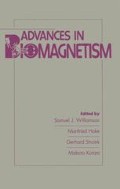Abstract
In the heart and brain coherent ionic currents flow across appreciable volumes producing detectable magnetic fields. In this paper I will survey other organs and processes which give rise to measurable fields. These are too diverse and numerous for the survey to be encyclopaedic: instead I will concentrate on those that have either attracted most attention or, in my view, seem most promising. They are:
-
Contaminant magnetic material in the body The body may contain, as contaminants, ferromagnetic or ferrimagnetic material. Magnetite Fe3O4 is commonly found in dust and is easily inhaled. It is a strong ferrimagnet and as little as a fraction of a gram of magnetite in the lungs is easily detectable. By measuring the field outside the chest it is possible to both monitor the dust burden of the lungs and assess lung function. The measurements are entirely non-invasive.
-
Intrinsic magnetic material in the body Overall, biological tissue is diamagnetic (with a susceptibility of order 10 −5 m−3) though, significantly, it does contain some paramagnetic material. In the Earth’s field; the presence of a biological organism changes the local magnetic induction by about 500 pT. SQUID magnetometers have sufficient sensitivity to map the local susceptibility variations of tissues as a way of probing their composition. This idea underlies a method of measuring stored iron levels in the liver.
-
Quasi dc ionic currents Because of the difficulty of making reliable dc electrode measurements on biological systems, many potentially significant electrophysiological processes are unexplored. ‘Injury current’ is an example. This may be a simple epiphenomenon, but it has been suggested that the currents have a significant role in the repair process. A linked suggestion is that the ionic currents that accompany development help to ’shape’ the organism. DC magnetic field studies of such phenomena may allow monitoring of hidden injuries and help to elucidate fundamental biological processes.
Access this chapter
Tax calculation will be finalised at checkout
Purchases are for personal use only
Preview
Unable to display preview. Download preview PDF.
References
Aittoniemi K., Kalliomaki K., Katila T. and Varpula T. 1981, Practical magnetopneumography using fluxgate magnetometers, in “Biomagnetism” Walter de Gruyter, 476–484.
Barth D.S., Sutherling W. and Beatty J. 1984 Fast and slow magnetic phenomena in focal epileptic seizures. Science 226, 855–857
Brain J.D., Bloom S.B. and Valberg P.A. 1988, Magnetometry -a tool for studying the cell biology of macrophages, in “Biomagnetism’87” Tokyo Denki Univ. Press, Tokyo, 10–17
Brain J.D., Gehr P., Valberg P.A., Bloom S.B. and Nemoto I. 1985, Biomagnetism in the study of lung function, in “Biomagnetism: Applications and Theory”, Pergamon Press, 378–387
Brittenham G.M., Farrell D.E., Harris J.W., Feldman E.S., Danish E.H., Muir W.A., Tripp J.H., Brennan J.N. and Bellon E.M. 1983, Diagnostic assessment of human iron stores by measurement of hepatic magnetic susceptibility. Il Nuovo Cimento, 2D, No. 2, 567–581
Buchanan D.S., Crum D.B., Cox D., and Wikswo Jr. J.P. 1989, This volume
Cohen D. and Kaufman L.A. 1975 Magnetic determination of the the relationship between the ST segment shift and the injury current produced by coronary artery occlusion. Circ. Res., 36, 414–424
Cohen D. 1978, Report of the low field group: the magnetic field of the lung. MIT/Francis Bitter Nat. Mag. Lab. Publication, 78/1
Cohen D., Palti Y., Cuffin B.N. and Schmid S.J. 1980, Proc. Natl. Acad. Sci. USA. 77, 1447–1451
Freake S.M., Swithenby S.J. and Thomas I.M. 1988, A miniature SQUID magnetometer for the detection of quasi dc ionic current flow in developing organisms, in “Biomagnetism’87” Tokyo Denki Univ. Press, Tokyo, 434–437
Farrell D.E. 1983, The magnetic biopsy, in “Biomagnetism An Interdisciplinary Approach” Plenum Press, 483–499
Freedman A.P., Robinson S.E., Street M.C. and Camplone D. 1984, Effect of cigarette smoking on alveolar clearance of particles, in Proc. of 5th. World Conference on Biomagnetism, Vancouver, Canada. Pergamon, New York. 43–45
Halperin M., Williamson S.J. Spektor D.M., Schlesinger R.B. and Lippman M. (1981), Remanent magnetic fields for measuring particle retention and distribution in the lungs. Exptl. Lung. Res. 2, 27–35
Kalliomaki K., Kalliomaki P.L., Korhonen O., Pasanen J., Aittoniemi K. and Moilanen M. 1983, Magnetopneumography, in “Biomagnetism An Interdisciplinary Approach” Plenum Press, 533–568.
Le Gros V., Lemaigre D., Suon C., Pozzi J.P. and Liot F. 1989, Magnetopneumography: a general review. Eur. Respir. J., 2, 149–159
Nemoto I., Ogura K. and Toyotama H. 1989, Estimation of the energy of cytoplasmic movements by magnetometry: effects of temperature and intracellular concentration of ATP. IEEE Trans. Biomed. Eng., BME-36, No. 6, 598–607
Okada Y.C. and Nicholson C. 1988, DC-coupled single trial measurements of the magnetic field during spreading depression in the cerebellum, in “Biomagnetism’87” Tokyo Denki Univ. Press, Tokyo, 202–205
Paulson D.N., Engelhardt R., Fischer R. and Heinrich H.C. 1989, The Hamburg biosusceptometer for liver iron quantification. This volume
Stroink G. 1985, Magnetic measurements to determine dust loads and clearance rates in industrial workers and miners. Med. Biol. Eng. Computing. 23, 44–49.
Swithenby S.J. 1988, Non invasive monitoring of ionic current flow during development by SQUID magnetometry. Experientia, 44, 673–678
Author information
Authors and Affiliations
Editor information
Editors and Affiliations
Rights and permissions
Copyright information
© 1989 Plenum Press, New York
About this chapter
Cite this chapter
Swithenby, S.J. (1989). Biomagnetic Studies of Organs Other than the Heart and Brain. In: Williamson, S.J., Hoke, M., Stroink, G., Kotani, M. (eds) Advances in Biomagnetism. Springer, Boston, MA. https://doi.org/10.1007/978-1-4613-0581-1_5
Download citation
DOI: https://doi.org/10.1007/978-1-4613-0581-1_5
Publisher Name: Springer, Boston, MA
Print ISBN: 978-1-4612-7876-4
Online ISBN: 978-1-4613-0581-1
eBook Packages: Springer Book Archive

